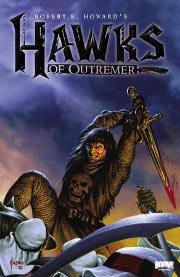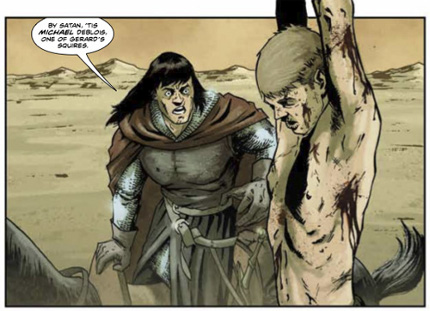Reading – Robert E. Howard’s Hawks of Outremer
Boom Studios (website, Twitter) may not have Howard’s big characters — Conan, Kull, Solomon Kane — but they did take one of the minor stories and produce an entertaining comic in the form of Hawks of Outremer*. Recently, while in Boston for PAX, I picked up the collection and then read it on the flight home. Now I want to take a little time to get my thoughts down, because what I read was a fun story that tells me Boom should adapt more of Howard’s lesser-known works to comics.

Unfamiliar with the Original Story
I have never once read the original story so I cannot even begin to compare Howard’s work to this comic adaptation. There is a 1979 hardcover edition of the story by Donald M. Grant (Amazon link*) that I would love to own in my collection, but today isn’t that day to add limited edition books to my personal library.
If you would like some thoughts on the comic by one who is far more qualified than me to compare the original story to the comic then see this post at The Cimmerian. Just keep in mind that the post was written based on preview material and by a hardcore Howard fan.
No, my own semi-review that follows is based solely on the comic and not on any preconceived thoughts that may have been generated by constant readings and rereadings of Howard’s original story. Does that make me less-than-qualified to even talk about the comic? I don’t know.

Greetings, Cormac Fitzgeoffrey

The star of the story, Cormac Fitzgeoffrey (Wikipedia), appears as a Conan-like character. According to Al Harron in this post at The Cimmerian this is not entirely accurate. Harron writes:
For one thing, Cormac is far too similar to Conan for my liking. There are certain aspects that are unavoidable–his haircut, for instance, is pretty Conan-esque, though even I recognize that’d be really nitpicking–but for some unfathomable reason, the comic actually adds elements from the Conan comics to further blur the lines.
Harron then goes on to list inaccuracies in the artwork that transform Cormac into Conan, but none of that matters in the end because I have to agree that the character, as shown in the comic, does look a hell of a lot like Conan. I suspect this was intentional; if I was tasked with directing the comic I would have instructed the artists to blend a little Conan into Cormac in an attempt to make the character semi-familiar to Conan fans. It’s simple marketing and the look doesn’t really bother me.

Welcome to the Crusades
Where Cormac and Hawks of Outremer* really starts to stand out as different from Conan is in the setting. As the opening panel of the comic tells us, this story is set during 1190 AD and we quickly learn that Cormac is a knight in Antioch (in Turkey, see Wikipedia) and, to the surprise of the guard at the beginning of the story and Cormac’s friends, Cormac is very much alive.
The story begins slowly — which reviews at Comic Book Resources and Broken Frontier disliked but I quite enjoyed — but begins to build as Cormac sets off to deal with Baron Conrad Von Gonler, a less-than-pleasant man who has committed treachery against one of Cormac’s friends (a now very dead friend). In almost every action Cormac takes a “kill now, talk later” approach which makes him feel even more Conan-like. This isn’t a bad thing, but it’s worth noting because if you do not enjoy Conan comics then you’re unlikely to enjoy this book.

A Tale of Vengeance
Hawks of Outremer* is, at its core, a story of one man seeking vengeance for the death of a friend. But rather than summarize each and every issue that makes up the collected story I’d rather spend time giving you my thoughts on the whole. If you just must read a review of each individual issue then I suggest seeing this review at Fandomania and continuing from there. All four issues are reviewed at the site.

Covers
The most-striking cover in the series, in my opinion, is the image shown above by the book’s artist, Damian Couceiro. Ominous and deadly, the image shows Cormac looking less like Conan than he does in the Joe Jusko covers. Jusko creates some fantastic cover paintings, but in this series some of the anatomy feels a bit off and the covers don’t feel as exciting as his Savage Sword of Conan work. The covers, for me, range from decent to beautiful.
Interior Artwork
Below you can see a panel by Damian Couceiro and, in the next image following that, the same panel colored by Juan Manuel Tumburus. Couceiro’s artwork in the book is sketchy at times, but overall it’s quite nice and does a great job of carrying the story along. There are a few panels in the book that feel rougher than I would have liked, but overall I have to say that this is excellent artwork and — though I hate to bring it up again — I could easily have seen Dark Horse using this artist for a Conan or a Solomon Kane story. This is quality work.

Writing
Again, having not read the original story I cannot say how this compares to Howard’s work, but going back to The Cimmerian we are told that the dialogue is basically Howard’s:
Also to be commended is that, as far as I can see, the dialogue from the story is more or less intact: vastly preferable to Tim Truman’s alterations in the Dark Horse “Black Colossus†arc. It’s fantastic to read things like “Avaunt! Back to hell with you, like a good knight†and “By the accursed gods! Does this hand feel like smoke?†with illustrations.
Fair enough, but how does it read as a comic? Quite well. It can get very wordy at times — a few word balloons toward the end of the story feel overlong — but in general it’s a fun read and a second reading of the book (it was a long flight, and my brain was severely damaged after about a week on the road) made me think that this is one of those comics I’ll come back to every few years. That, to me, is always the sign of a good book.

Closing Thoughts
In Hawks of Outremer* Boom Studios has shown me that they can adapt Howard’s work into comic form and do so in a way that makes me happy. The artwork is mostly excellent, the writing fun to read, and the story moves quickly from a slow, deliberate pace to a rush of violence.
What I’ve seen here has me hoping that Boom adapts the next Cormac Fitzgeoffrey story to comic form. And it has me itching to read Howard’s original version of the story . . . which isn’t exactly a good thing since I’d rather read it in that Donald M. Grant collection than in any other edition.
And that Grant book is definitely pricier than if I just settled for reading the stories on my Kindle.

A very good review, and I’m glad you found my article useful! Having read the whole series since then, my initial thoughts were confirmed: a few unfortunate historical groaners and one or two strange deviations from the source material, but for the most part, an excellent adaptation of the story.
That said, I don’t see why you should shell out for the Grant edition: “The Sword Woman and Other Historical Adventures” has the two stories and fragment, with beautiful illustrations by John Watkiss. A fraction of the price with dozens more fantastic stories in the bundle.
@Al – Basically, I am insane. I have some other Grant books and they’re gorgeous. But you’re right, there’s no need for me to grab the Grant edition just to read the stories. I may just go ahead and download the Kindle edition for reading, but that won’t stop me from wanting that Grant book.